Impacted By SmileDirectClub Closing?
Braces Instructions
- Unveiling Experts Tips For A Flawless Orthodontic Journey
- Achieve The Smile Of Your Dreams When Following Orthodontic Experts’ Braces Care Advice
- Taking Care Of Braces During Treatment
- Brushing & Flossing With Braces
- Brushing
- Flossing
- Eating With Braces
- Living With Braces
- Discomfort Management
- Dealing With At-Home Braces Emergencies
- Winning Smiles
- Get Ready To Flaunt Your Perfect Smile With Orthodontic Experts
- FAQs
Unveiling Experts Tips for a Flawless Orthodontic Journey
Are you looking for braces instructions? Orthodontic Experts has the answers! We understand that you have many options when it comes to choosing the right orthodontic treatment. That’s why we offer a wide range of services, including Traditional Metal Braces, Rose Gold Braces, and Clear Aligners. Whether you need to straighten your teeth or correct your bite, we have the expertise and experience to help you achieve your goals. Get ready to embrace the journey towards a confident and beautiful smile with our precise and personalized brace instructions.
Achieve the smile of your dreams when following Orthodontic Experts’ Braces Care Advice
Achieving a beautiful smile with Orthodontic Experts doesn’t have to be complicated. We offer a comprehensive suite of orthodontic treatments, from Traditional Metal Braces to cutting-edge Rose Gold Braces. And our braces instructions make it easy to get started on your journey toward greater oral health and a stunning smile.

At Orthodontic Experts, we strive to keep our orthodontic services affordable and easily accessible. With multiple offices in various locations, it’s simple to find an Orthodontic Experts clinic near you. Moreover, we offer a no-cost initial appointment to help determine which type of treatment is best for your needs and budget.
Our complete braces instructions cover everything you need to know about getting started with orthodontic treatments, from what sets us apart from other providers to the protocols used in each visit. With our clear guidance and helpful resources, you can feel confident that you are making the right choice for your smile today – and for many years to come.
Taking Care of Braces During Treatment
Caring for your braces during treatment is key to making sure that you have a successful orthodontic experience with Orthodontic Experts. Below are some important tips to keep in mind throughout the duration of your braces treatment:

Brushing
Braces give bacteria more places to hide, so it is crucial that you brush carefully around every bracket and wire, at least twice a day. We recommend using a soft-bristled toothbrush and fluoride toothpaste.
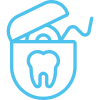
Flossing
Flossing can be challenging with braces, but it is still essential. Use a floss threader to get the floss under the wires and between the teeth. Consider investing in an interdental brush or water flosser to make flossing easier.

Watch What You Eat
Foods that are hard, sticky, or chewy can damage or dislodge your braces and wires. Avoid foods like popcorn, gum, caramel, hard candy, ice, nuts, and raw vegetables. Instead, stick to soft foods like soups, yogurt, pasta, and mashed potatoes.

Protect your braces
If you play sports, it’s important to wear a mouth guard to protect your teeth and braces from injury. For those who play contact sports, there are special mouth guards designed to protect braces.

Attend Regular Appointments
Regular appointments with your orthodontist are important to ensure your braces are working correctly. Typically, appointments are scheduled every four to six weeks, at which time your orthodontist will check on your progress and adjust your braces if needed.

Dietary Modifications
In addition to brushing and flossing every day, make sure you follow a healthy and balanced diet. Limit sugary drinks and snacks, and drink plenty of water to keep your mouth hydrated.
These tips on caring for your braces will help ensure that you receive optimal results following your orthodontic treatment at Orthodontic Experts!
Brushing & Flossing With Braces
Maintaining Good Oral Hygiene
Good oral hygiene is key when you’re wearing braces, and it’s important to brush and floss daily to help keep your teeth and gums healthy. The good news is, brushing and flossing with braces isn’t as hard as it might seem!
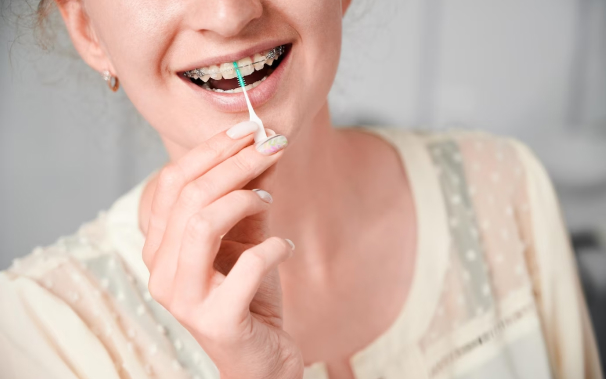
Brushing
Brushing your teeth with braces on takes a bit of extra care, since there are extra places where food particles can get stuck. For best results:
- Start by brushing your molars first.
- Angle your toothbrush at 45° so the bristles get underneath the brackets and into the gumline.
- Take your time—brush gently at each tooth for 10-15 seconds. Use a pea-sized dab of fluoridated toothpaste when brushing and make sure you don’t forget any areas.
Flossing
Using an interdental brush is the easiest way to floss when you have braces. Here’s how to use one:
- Put the interdental brush between the main wire of your braces and the gum line above or below each molar. Push it down into the area, then lift it up a few times for maximum advantage.
- Move on to other teeth in a similar manner, making sure to move slowly along your gums as you go, taking care not to injure them in any way during cleaning or flossing operations.
- If necessary use waxed dental floss to clean around appliances like wires and rubber bands that may be too large for an interdental brush to reach between them effectively .
- Rinse thoroughly afterwards with warm salt water or antiseptic mouthwash or rinse recommended.
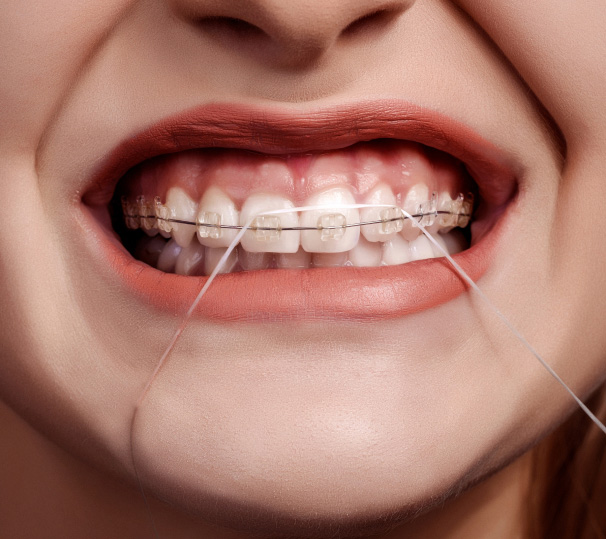
Eating With Braces
Foods to Avoid and Teeth-Friendly Snacks
You now have your braces, and you’re ready to go on your way towards straighter teeth and a healthier bite. With braces, it’s important to remember that while they’re helping make your smile healthy, you still need to take care of them too. Here is an easy guide for eating with braces:
Foods to Avoid with Braces
While undergoing orthodontic treatment, certain foods can damage or even break your brackets and wires. Here are some foods you should avoid with braces:
- Hard candies and chewy candy like caramels and gummies
These sweets can damage your brackets and wires and leave a sticky residue on your teeth.
- Popcorn
Eating popcorn can easily damage your wires, leading to discomfort and even more visits to the orthodontist.
- Nuts and seeds
These can be difficult to chew and can easily get lodged between your braces and teeth.
- Crunchy fruits and vegetables
While fruits and veggies are a healthy snack option, you should avoid biting into hard, crunchy ones like apples or carrots. Instead, cut them into smaller pieces to make them easier to eat with braces.
- Hard, crusty bread
Certain breads like bagels and French bread can be tough to bite into and can even dislodge your brackets.
Teeth-Friendly Snacks
Just because you have braces doesn’t mean you can’t enjoy tasty snacks. Here are some foods that are easy on your braces:
- Smoothies and milkshakes
These can be made with soft fruits and veggies and are a great way to get your daily dose of vitamins.
- Soft cheeses
Cheese is full of calcium and is a great source of protein. Just make sure it’s a soft variety like brie or cream cheese.
- Yogurt
Another great source of protein and calcium, yogurt is easy to eat and can make a great base for a smoothie.
- Soft fruits like bananas and berries
These can be easily mashed or blended into a smoothie or used as a topping for yogurt.
- Cooked vegetables
Steamed or roasted vegetables like broccoli, carrots, and sweet potatoes are easy to eat and provide a range of vitamins and minerals.
By following these tips on eating with braces, you’ll help keep your teeth healthy while making sure the orthodontic treatment works effectively. At Orthodontic Experts we’re here to help answer any questions you might have—reach out today for more information on our affordable orthodontic treatments!
Living With Braces
Embrace the Change
Once you begin your journey with Orthodontic Experts, there are some important lifestyle changes that you should keep in mind as you live with braces.
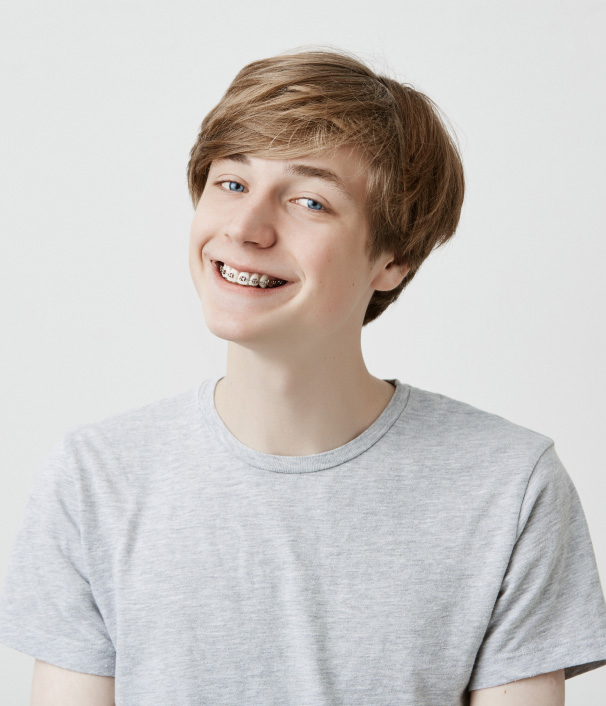
- Food Adventures
Explore new culinary horizons with braces-friendly foods like soft fruits, cooked vegetables, pasta, and smoothies. Say hello to creative recipes!
- Oral Care Crusade
Brushing and flossing become superheroes in your oral care routine. Keep those pearly whites shining by dedicating extra time to maintain excellent hygiene.
- Sporting Champion
Protect your smile during sports activities with a custom-fit mouth guard. It’s a game-changer in preserving your braces and teeth from potential injuries.
- Speech Symphony
Embrace the adjustments in your speech pattern as you adapt to wearing braces. Practice pronouncing words and allow yourself time to adjust. Confidence is the key!
- Fashion Forward
Use your braces as a fashion statement! Customize your orthodontic journey with colorful elastics that show off your unique style and personality.
Discomfort Management
Instructions for Orthodontic Patients
Braces may make you feel sore or tender, especially during the first few days of treatment. This is perfectly normal and the discomfort should ease up over time. You can help manage your discomfort by:
Soreness Soothers
Over-the-counter pain relievers, such as ibuprofen or acetaminophen, can help alleviate the soreness and discomfort associated with braces. Follow the recommended dosage and consult with your orthodontist if needed.
Wax Magic
If braces wires or brackets are causing irritation or ulcers inside your mouth, applying orthodontic wax can provide a protective barrier and reduce friction. Simply roll a small amount of wax and apply it to the problematic area for instant relief.
Pressure Relief
Chewing sugarless gum or hard candy to help release pressure from the wire on your teeth.
Saltwater Soothing
Rinse your mouth with a warm saltwater solution to help alleviate soreness, promote healing, and reduce inflammation. Dissolve half a teaspoon of salt in a cup of warm water and swish it gently around your mouth for about 30 seconds.
Soft Food Delight
Opt for soft and easy-to-chew foods, especially during the initial days after getting braces or following an adjustment. Soups, yogurt, mashed potatoes, and smoothies are gentle on your teeth and can minimize discomfort while still providing nourishment.
Oral Hygiene Heroics
Maintain impeccable oral hygiene to prevent additional irritations and sores. Brush gently and thoroughly, paying attention to hard-to-reach areas.

Dealing with At-Home Braces Emergencies
Occasionally, wires may poke your mouth or your braces may become loose. If you’re dealing with an at-home braces emergency, the team at Orthodontic Experts is here to help. Most likely, you can fix the issue until you come in for your next appointment using these tips:
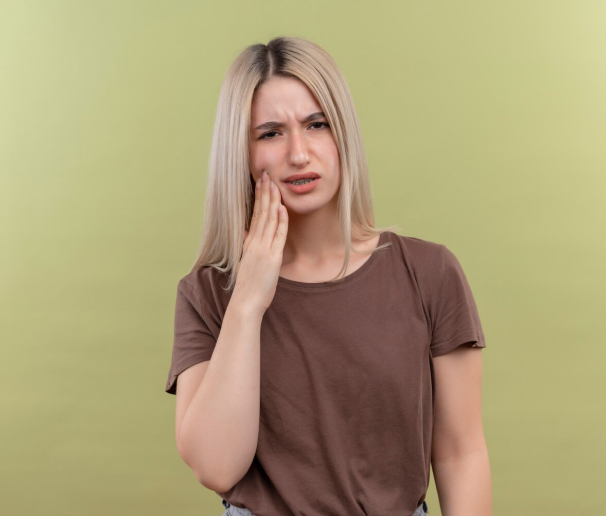
Poking Wires
Don’t panic if a wire has come loose and is poking you—there are common ways to relieve the pain. If you have a poking wire, cover the end with orthodontic wax to avoid it from irritating your mouth. In case you don’t have wax, use a cotton ball, a small piece of gauze, or even a small piece of soaked chewing gum. Make sure to place the wax or whichever material you’re using firmly against the poking wire’s end.
If the poking wire is long, use clean nail clippers to cut the wire, making sure to disinfect the clippers before and after use. If the wire is too short to cut or bend, try pushing it back into place using a pencil eraser or a cotton swab. If this doesn’t work, call Orthodontic Experts and our emergency orthodontist will assist you.
Braces Wire Slipped Out
If you are an orthodontic patient and your braces wire has completely slipped out at home, don’t panic. First, wash your hands with soap and water to minimize the risk of introducing any bacteria into your mouth. Second, use a clean pair of tweezers to carefully replace the wire back into the brackets. If this is not possible, use wax to cover the edges of the wire and book an appointment with our orthodontist as soon as possible.
Loose Brackets
When a bracket is loose, it can rub against your cheeks, leading to sore spots’ development. If you notice a loose bracket, call Orthodontic Experts as soon as possible to schedule an appointment to fix it. Our orthodontist will examine it and, if necessary, reattach it with orthodontic cement. While waiting for your appointment, you can use orthodontic wax to cover the bracket to prevent it from rubbing against your cheeks or lips.
Winning Smiles
Breaking Stereotypes in Sports With Braces
If you’re an athlete, you know that braces have become part of the norm in sports. Even the biggest professional athletes wear their braces proudly, breaking the stereotype that braces are only for kids and young adults.
Accidents happen, especially in contact sports like football, hockey, and basketball. While wearing braces can help align your teeth and improve your bite, they also increase the risk of injury to your mouth. A mouth guard creates a barrier between your braces and your cheeks, lips, and tongue, protecting them from cuts, scratches, and other injuries.
At Orthodontic Experts, we’re passionate about not only straightening our patients’ teeth, but also ensuring their overall dental health. Make sure to wear your mouth guard during every game, and take good care of it to ensure it lasts a long time.

Don’t let preconceived notions of what it means to be an athlete keep you from achieving your goals. With Orthodontic Experts’ individualized approach to orthodontic treatment, we can help take your competitive spirit and performance to the next level!

Get Ready to Flaunt Your Perfect Smile with Orthodontic Experts
Ready to flaunt your perfect smile? With Orthodontic Experts, you can get the treatment you need to make that dream a reality.
Taking care of your braces is an essential part of your orthodontic treatment, and at Orthodontic Experts, we make that easy. We understand that braces can be overwhelming and complex, so we provide education and guidance to our patients every step of the way. We want you to have the best orthodontic experience possible, and having the right information is key to making that happen.
Whether you need help keeping your braces clean and in great condition, are struggling with eating and speaking with braces, or just need general braces instructions, Orthodontic Experts has you covered. Contact us today to get started!
frequently asked questions
Will my braces hurt?
One of the most common concerns when it comes to getting braces is the pain associated with them. While it’s true that your mouth may feel sore for a few days after getting your braces put on or adjusted, this discomfort is typically mild and can be managed with over-the-counter pain medication. If you experience any sharp or intense pain, be sure to contact our local orthodontists near you.
How long does it take to get used to wearing braces?
It’s normal to feel a little uncomfortable or awkward when you first get braces. It may take a few days to a week to adjust to them, but rest assured that you’ll soon get used to the sensation of having braces in your mouth. In the meantime, stick to your orthodontists instructions after getting braces and avoid anything crunchy or chewy that could damage your brackets or wires.
Can I eat anything I want with braces?
No! While you can still enjoy most of your favorite foods with braces, there are certain things you should avoid to keep your orthodontic care on track. Sticky, hard, or chewy foods, such as caramel, popcorn, and gum, can all damage your braces and make it harder to keep your teeth clean. Stick to softer or blended foods, such as smoothies and soup, to help ease any discomfort and avoid damaging your braces.
What should I do if I experience pain or soreness after getting braces?
After you get your braces, it’s common to feel some discomfort or soreness. This is because your teeth are adjusting to the new pressure of the braces. You can take over-the-counter pain relievers like acetaminophen or ibuprofen to help ease any pain. You can also try rinsing your mouth with warm saltwater or using an ice pack to reduce swelling. If the pain is unbearable or lasts for more than a few days, contact your orthodontist. They may be able to adjust your braces or provide you with additional pain relief instructions.
How do I properly clean and maintain my braces?
Cleaning your braces is essential to maintaining good oral hygiene. Use a soft-bristled toothbrush and fluoride toothpaste to brush your teeth at least twice a day. You should also floss at least once a day to remove any food particles that are stuck between your teeth and braces. It’s best to use a floss threader or interdental brush to reach those hard-to-reach areas. After you brush and floss, use an antibacterial mouthwash to kill any remaining bacteria in your mouth. Be sure to avoid hard, sticky, or sugary foods that can damage your braces and make it harder to keep them clean.
Can I still play a musical instrument with braces?
Yes, you can still play a musical instrument with braces. It might take some time to adjust to how your teeth and braces feel, but with some practice and patience, you’ll be able to play just as you did before. Many professional musicians have played with braces, and if they can do it, so can you! If you play a wind instrument, there are some tips to keep in mind. Try using a little more pressure than usual, and take breaks if your mouth starts to feel sore. You can also talk to your orthodontist about getting a special mouth guard to protect your braces.

